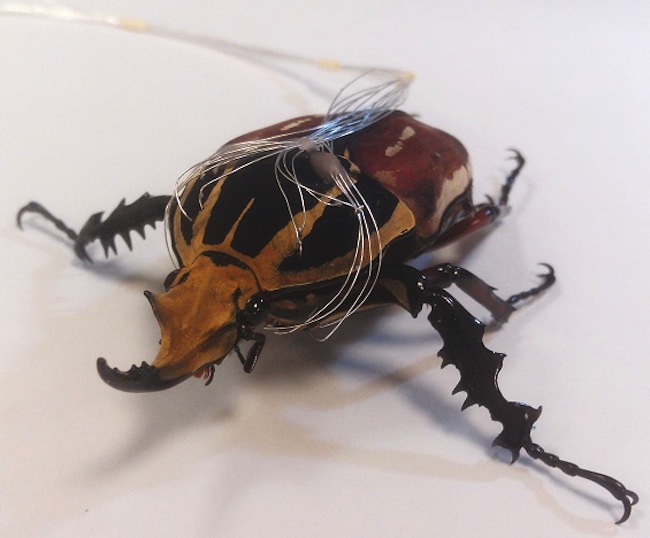Scientists Hijack Bugs, Turn Them into Cyborgs
By implanting electrodes into the muscles of beetles, scientists can now precisely control how cyborg insects walk — an ability that may help these bugs carry out complicated tasks, researchers said in a new study.
For decades, scientists have looked to insects for inspiration when designing robots, with the hope of learning from millions of years of evolution. After all, insects may be the most successful animals on Earth, making up about 75 percent of all animal species known to humanity.
In the past two decades, instead of attempting to create intricate robots that mimic the complexity of the insect form, researchers have tried hijacking bugs to turn them into robots themselves. Scientists can already control the flight of live moths using implanted electronics. Such cyborg insects could find a wide variety of uses, from espionage to search-and-rescue missions. [Video: It Walks! Scientists Turn Beetle Into 'Cyborg']
Although the researchers acknowledged that cyborg insects do have a number of drawbacks compared to true robots, such as limited life spans, they have several advantages, too. For example, insects are ready-made platforms, so inventors wouldn't have to devise and integrate countless tiny parts. Cyborg insects also consume about 100 times less power than robots of comparable size and do not "need complicated code to overcome obstructions" as robots do, study co-author Hirotaka Sato, a mechanical engineer at Nanyang Technological University in Singapore, told Live Science. "We can just shut off our controls and let the insect overcome the obstructions by itself."
Previous research used electrical signals to spur cyborg insects to walk via electrodes wired to their antennas or brains. However, such connections could often prove unreliable, and scientists had no control over the speed or gait of the insects, the researchers said.
Instead of wiring the insects' antennas or brains, Sato and his colleagueswired the insects' muscles to control the way they walked — a strategy the researchers say can improve the agility of cyborg insects toward practical applications. [Robots on the Run! 5 Bots That Can Really Move]
Scientists experimented with Mecynorrhina torquata, a giant beetle native to central Africa that can grow to be up to 3.3 inches (8.5 centimeters) long. The researchers experimented with live male beetles purchased from a beetle company in Taiwan. (The males are the larger sex of the species.)
Get the world’s most fascinating discoveries delivered straight to your inbox.
The scientists implanted eight pairs of electrodes in each beetle. These electrodes controlled eight muscles in the front legs of each beetle. Electrically stimulating the muscles could make the legs extend or retract, and lower or lift, the researchers said.
The scientists analyzed the natural 3D motions of the beetle legs to understand what sequences of motions normally occurred when the insects walked. Next, they developed sequences of electrical stimulation designed to precisely alter the beetles' step frequency, which, in turn, adjusted their step length and walking speed.
A future goal of this research is to control all six legs of insects, Sato said. The scientists also want to introduce systems to help monitor the positions of the cyborg insects and steer their paths toward specific targets, he added.
The scientists detailed their findings online March 30 in the Journal of the Royal Society Interface.
Follow us @livescience, Facebook & Google+. Original article on Live Science.




